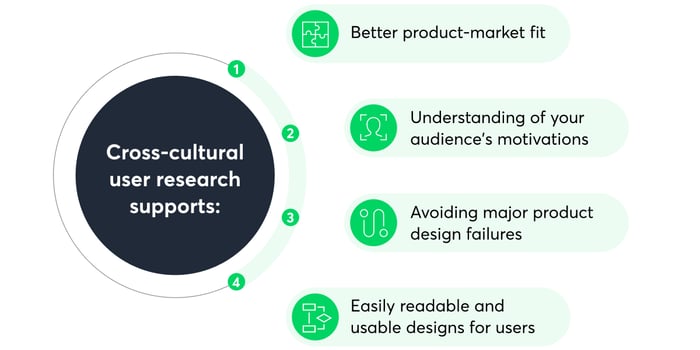Cross-Cultural User Research - All You Didn't Know About Your Users

Cross-cultural user research is one of the best ways to ensure you are designing and creating for all members of your user base.
What is cross-cultural user research? And why are so many companies engaging with cross-cultural study methods to understand their audience and gain a competitive edge?
Cross-cultural user research has surged in recent years alongside movements to be more inclusive in both business and cultural spheres. There is no need for user research to be narrow or limited. In fact all the evidence suggests that this type of research is integral if you want to sustainably grow your user base and create successful designs.
What is cross-cultural user research?
If you want to fully understand who your market is outside your country, culture, language, and cultural norms, cross-cultural user research is the perfect method to achieve that.
Today, it is important that UX designers, product or project managers, and everyone involved in the creative process attempt to understand the wide array of human behaviors out there.
Cross-cultural comparison helps you appreciate the culture variation within your audience, test hypotheses, and design products and services with better understanding of your users in mind.
When you’re dealing with multicultural design, the help of cross-cultural researchers may come handy, as you should expect to confront various cultural factors. Those might be cultural values that differ from those accepted in your own culture or many unfamiliar cultural groups working in their own specific ways.
As more designers, developers and managers become aware of the cultural differences within their audiences, we’re starting to see more products and services that cater to the full spectrum of human behavior. Inevitably, this means better, more accessible, more inclusive creations.
Cross-cultural user research should be a foundation for any businesses that operate internationally or within multicultural societies. Understanding your audience and users is a key step in any design process, as you, in fact, design for people, not for the sake of design itself.
Successful cross-cultural design is an outcome of great user research. Let’s take a look at a few of the most popular cross-cultural research methods that businesses use today.
Cross-cultural research methods
There are several ways to approach user research. So, what methods can you employ to ensure that your user research is both cross-cultural and effective?
Social psychology research
This type of research aims to uncover the psychological characteristics of large communities. It is difficult for a UX researcher to conduct such a comparative study between communities on their own. Instead, here you can rely on what scientists have already done and use the formerly behavior science research.
The basic tool is desk research, which is a good practice to help deepen the knowledge of the community in which the product operates. This way you will be able to create products that address the common needs within certain cultural groups.
Qualitative research
In-depth interviews, combined with usability testing, can also be used as a form of qualitative user research.
By collecting and analyzing non-numerical data you will be able to understand and categorize a wide array of conceptions, opinions and experiences. The data you will receive from this kind of research will help you reach the motives of your users.
Eye tracking and analytical data
More technical methods, like eye tracking can be used to understand the unconscious behavior of users. It makes a good insight for further cross-cultural comparisons and analyzes of different cultures’ behaviors. These comparative studies are key to understanding the specific differences and commonalities across world cultures.
Inclusive, contextual research
Contextual research, that aims to understand the circumstances of your users and understand how they might interact with your product, is a key cross-cultural user research method.
What is a major flaw of cross-cultural research?
While there are a number of important benefits derived from successful cross-cultural study, it is also important to consider possible flaws in this particular method of research. When is cross-cultural analysis a hindrance rather than an insightful knowledge?
In some cases, there is a limit to how far you can go with your research and the cross-cultural comparisons you can feasibly draw.
It is difficult to explore each cultural context or a possibility because eventually you have to start creating and designing your product or service.
For example, if we build an online store with jackets that we want to sell in the EU, it would be difficult to carry out a trial in all 27 countries. Even if there were significant differences between countries, the perks of a more tailored approach may not offset the cost of maintaining 27 different versions of the store. Equally, the time it would take to conduct their cross cultural tests may detrimentally delay the design process.
Similarly, sometimes it’s not feasible, worthwhile, or even necessary to have local designs for every culture, especially for smaller businesses. In this case, products or services rely mostly on translation and simply offer multiple language options. It is important to know the exact scope of your operations before you start employing cross-cultural methods within your research.
You have to ask yourself, “Is cross-cultural research feasible, practical and useful for the creation of this specific product?” In most cases the answer will be “Yes!”. Nevertheless, it is vital to ask these questions each time and understand the practical elements of your process before you start any user research project.
Why is cross-cultural research important?
Cross-cultural user research is now a vital part of the product life cycle for many businesses like Amazon, Uber, and Apple. It provides extensive cultural knowledge, especially about cultural differences, and allows business to make informed decisions about products and campaigns.

Let’s take a look at the role it can play and why, in some cases, it is one of the key factors of creating successful products.
Better understanding of your audience's motivations
You may have a picture of your ideal user or audience in your mind. However, it is unlikely that everyone fits into this mold and if you are only designing for that one type of user you are neglecting the rest of your possible future customers.
Cross-cultural user research helps you gain a greater understanding of the complexity and the variety of your audience’s motivations. This in turn will help you make informed business decisions and create products that actually address real consumer problems. This research approach can set you apart from competitors and help to inspire your creative process.
Better product-market fit
Another ‘pro’ is the fact that cross-cultural studies will help you create a product that is suited to the local market. Comparative studies and specific cultural data collection will take local conditions into account and help you formulate appropriate business strategies.
For example, when Uber expanded around the world they didn’t just copy and paste their ridesharing app for each country. Instead, they thought of the cultural environment of each city and country.
In Paris, Uber decided to create a collaboration with Cityscoot in order to add scooters to their existing fleet. In a constantly moving city, Uber knew that providing more flexible and easy-to-use alternatives was a way to adapt to the local habits.
Besides Paris, Uber is also adapting to the transportation culture in Istanbul by allowing their users to book an Uberboat (operated by the local company Navette), to help users avoid the car and railway traffic that inflicts the city.
Avoiding major product design failures
When Amazon launched in India back in 2008, they faced issues because of their lack of cultural insight and comprehensive UX research. Amazon couldn’t understand why their Indian customers weren’t using one of their chief revenue drivers: product search allowing purchase on the homepage of the mobile site.
It appeared that the majority of their customers in India didn’t associate the image of a magnifying glass with the concept of searching. When the UI was examined and further research was conducted, Amazon found that most of their Indian customers thought that the icon represented a ping-pong paddle.
Amazon’s solution to this problem was to continue using the magnifying glass but assimilate a search field with a Hindi text label to make people know that this was where they could start a search. If thorough cross-cultural studies were conducted this product design failure could have been completely avoided.
Creating designs that are easily readable and usable for users
Last, but not least, cross-cultural research helps to understand the different ways in which information architecture can be presented and designed, which highly affect communication with users.
In the West, the ideal way of presenting and communicating information is by presenting it in a minimalist, distraction-free manner. The rule of thumb is “less is more”. However, this convention is not applicable in some Asian countries.
For example, when Mozilla Firefox created localized landing pages for countries around the world, they made sure to research and incorporate the cultural sensibilities of specific countries. As a result, the American site is minimal and clean with one clear CTA (call-to-action). Whereas, the Chinese version has much more content — banners, news, and ads that fill all the available space.
Make products for people with cross-cultural user research
Cross-cultural user research has helped many companies produce accessible, creative, and relevant products. Now that you know more about it and the various methods, you can get started with your own research or use the help of an external team of cross-cultural researchers.
We’ve found that there is a positive correlation between the quality of a business’s cross-cultural user research and the ability of that business to create designs that solve problems for a wide variety of cultural groups. As with most areas of business, knowledge is the key to success.
If you are interested in elevating your product design so it would fit different markets, check out user research methods that can help your product fit the chosen audience.









%20(1).jpg?width=384&height=202&name=tablet%20and%20flowers%20(1)%20(1).jpg)







.jpg?width=384&height=202&name=Orbem%20website%20on%20a%20laptop%20(1).jpg)




.jpg?width=384&height=202&name=ux-indonesia-qC2n6RQU4Vw-unsplash%20(1).jpg)
